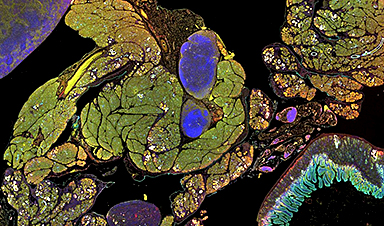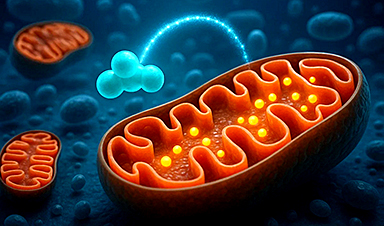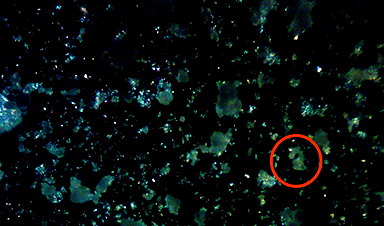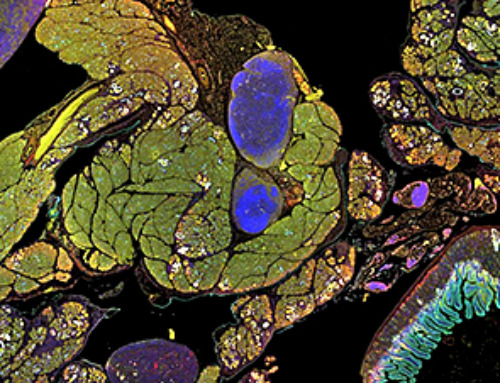A new technology co-developed at EMBL Hamburg provides new insights into mRNA pharmaceuticals and other nanomedicines, which can be helpful for the development of new products
Many novel mRNA nanomedicines, which are currently in different stages of development, may become available in the future. One requirement for all applications of mRNA in pharmaceutical products is that they need to be formulated in suitable delivery systems, each designed for different functions and optimized for therapeutic product needs based on the intended application and route of delivery.
Lipid-based nanoparticles are tiny droplets of fat-like molecules that serve as protective packaging for the mRNA. Their properties depend on composition, structure, manufacturing protocol, and other conditions.
An important aspect of nanoparticles is their size. By their nature, nanoparticles can vary a little bit in size, some being a bit smaller, and some a bit larger than the average value. The particle size can have an influence, for example, on the stability and the behavior of the formulations after administration. It is therefore important to control the particle size inside a pharmaceutical product to evaluate and ensure its quality.
Scientists at EMBL Hamburg, Johannes Gutenberg University Mainz, Postnova Analytics GmbH, and BioNTech SE have developed a new method to precisely elucidate the size of all particles in such pharmaceutical products, as well as their structure and how many RNA molecules they carry inside them. The study was conducted based on lipoplex formulations, an mRNA delivering technology developed by BioNTech. The work is published in the journal Scientific Reports.
“So far, it was very difficult to measure all these size-related properties; therefore, often only average values were determined,” said Heinrich Haas, one of the leaders of the project. “With our new method, we can determine many size-related features all at once, with a single measurement and for all nanoparticles in a product. This information can be handy to evaluate product quality.”
The method will also be applicable for the investigation of other pharmaceutical products.
“Liposomes are another type of pharmaceutical nanoparticles which have been applied for years for the treatment of cancer or infectious diseases such as fungal infections,” said Peter Langguth, the project leader at Johannes Gutenberg University Mainz.
“Now even generic liposome products are available on the market, and probably there will be more to come. The new method can be very useful in evaluating the quality of these generics in comparison to the originator products and will pave the way for further high-quality drug products at an even more reasonable cost.”
A two-in-one method
What makes the new method so powerful is that it couples two techniques: asymmetrical-flow field-flow fractionation (AF4) and small-angle X-ray scattering (SAXS). AF4 separates lipid-based nanoparticles from other parts of an mRNA nanomedicine and sorts them according to their size.
SAXS allows scientists to determine the structure and the number of sorted particles. To do this unequivocally, only one type of particle must be analyzed at a time, which is why combining sorting and measuring is so critical.
SAXS is one of the key techniques applied and available at EMBL Hamburg as a service for researchers from academia and industry in Europe and beyond. EMBL Hamburg’s SAXS beamline at the PETRA III synchrotron, now equipped with the AF4 device—set up with the help of collaborators at Postnova Analytics GmbH—will open up new opportunities not only for studying pharmaceutical nanoparticles, but also for other types of research.
“The combination of these two tools can now be used in many different areas of science,” said Melissa Graewert, Staff Scientist at EMBL Hamburg.
“In addition to helping create new medicines, we can also use them to understand how different-sized particles interact in complex biological systems. For example, I’ve now used this new setup to closely examine how very small plastic debris called nanoplastics, which pollute our waters, can be covered by binding proteins on their surface. A key question is whether this protein shielding enables nanoplastics to travel through our bloodstream, potentially reaching different organs, as they may no longer be recognized as foreign objects by our immune system.”
This work follows up on several previous collaborative studies between EMBL Hamburg, BioNTech SE, and Johannes Gutenberg University Mainz, which explored how mRNA can be better formulated and delivered into human cells. The scientists are continuing their collaborative research to further explore the application of mRNA nanomedicines.
More information: Melissa A. Graewert et al, Quantitative size-resolved characterization of mRNA nanoparticles by in-line coupling of asymmetrical-flow field-flow fractionation with small angle X-ray scattering, Scientific Reports (2023). DOI: 10.1038/s41598-023-42274-z
Journal information: Scientific Reports
News
Studies detail high rates of long COVID among healthcare, dental workers
Researchers have estimated approximately 8% of Americas have ever experienced long COVID, or lasting symptoms, following an acute COVID-19 infection. Now two recent international studies suggest that the percentage is much higher among healthcare workers [...]
Melting Arctic Ice May Unleash Ancient Deadly Diseases, Scientists Warn
Melting Arctic ice increases human and animal interactions, raising the risk of infectious disease spread. Researchers urge early intervention and surveillance. Climate change is opening new pathways for the spread of infectious diseases such [...]
Scientists May Have Found a Secret Weapon To Stop Pancreatic Cancer Before It Starts
Researchers at Cold Spring Harbor Laboratory have found that blocking the FGFR2 and EGFR genes can stop early-stage pancreatic cancer from progressing, offering a promising path toward prevention. Pancreatic cancer is expected to become [...]
Breakthrough Drug Restores Vision: Researchers Successfully Reverse Retinal Damage
Blocking the PROX1 protein allowed KAIST researchers to regenerate damaged retinas and restore vision in mice. Vision is one of the most important human senses, yet more than 300 million people around the world are at [...]
Differentiating cancerous and healthy cells through motion analysis
Researchers from Tokyo Metropolitan University have found that the motion of unlabeled cells can be used to tell whether they are cancerous or healthy. They observed malignant fibrosarcoma cells and [...]
This Tiny Cellular Gate Could Be the Key to Curing Cancer – And Regrowing Hair
After more than five decades of mystery, scientists have finally unveiled the detailed structure and function of a long-theorized molecular machine in our mitochondria — the mitochondrial pyruvate carrier. This microscopic gatekeeper controls how [...]
Unlocking Vision’s Secrets: Researchers Reveal 3D Structure of Key Eye Protein
Researchers have uncovered the 3D structure of RBP3, a key protein in vision, revealing how it transports retinoids and fatty acids and how its dysfunction may lead to retinal diseases. Proteins play a critical [...]
5 Key Facts About Nanoplastics and How They Affect the Human Body
Nanoplastics are typically defined as plastic particles smaller than 1000 nanometers. These particles are increasingly being detected in human tissues: they can bypass biological barriers, accumulate in organs, and may influence health in ways [...]
Measles Is Back: Doctors Warn of Dangerous Surge Across the U.S.
Parents are encouraged to contact their pediatrician if their child has been exposed to measles or is showing symptoms. Pediatric infectious disease experts are emphasizing the critical importance of measles vaccination, as the highly [...]
AI at the Speed of Light: How Silicon Photonics Are Reinventing Hardware
A cutting-edge AI acceleration platform powered by light rather than electricity could revolutionize how AI is trained and deployed. Using photonic integrated circuits made from advanced III-V semiconductors, researchers have developed a system that vastly [...]
A Grain of Brain, 523 Million Synapses, Most Complicated Neuroscience Experiment Ever Attempted
A team of over 150 scientists has achieved what once seemed impossible: a complete wiring and activity map of a tiny section of a mammalian brain. This feat, part of the MICrONS Project, rivals [...]
The Secret “Radar” Bacteria Use To Outsmart Their Enemies
A chemical radar allows bacteria to sense and eliminate predators. Investigating how microorganisms communicate deepens our understanding of the complex ecological interactions that shape our environment is an area of key focus for the [...]
Psychologists explore ethical issues associated with human-AI relationships
It's becoming increasingly commonplace for people to develop intimate, long-term relationships with artificial intelligence (AI) technologies. At their extreme, people have "married" their AI companions in non-legally binding ceremonies, and at least two people [...]
When You Lose Weight, Where Does It Actually Go?
Most health professionals lack a clear understanding of how body fat is lost, often subscribing to misconceptions like fat converting to energy or muscle. The truth is, fat is actually broken down into carbon [...]
How Everyday Plastics Quietly Turn Into DNA-Damaging Nanoparticles
The same unique structure that makes plastic so versatile also makes it susceptible to breaking down into harmful micro- and nanoscale particles. The world is saturated with trillions of microscopic and nanoscopic plastic particles, some smaller [...]
AI Outperforms Physicians in Real-World Urgent Care Decisions, Study Finds
The study, conducted at the virtual urgent care clinic Cedars-Sinai Connect in LA, compared recommendations given in about 500 visits of adult patients with relatively common symptoms – respiratory, urinary, eye, vaginal and dental. [...]





















